Before today, humankind has never been able to support 6.8 billion people. We know this because, if each woman at the time of Christ had only three children, and each lived to 60 years of age, the 150 million people existing then would have grown to 6.8 billion by the year 400. The primary reason population did not grow that fast was our social organization could not create the goods and services to allow it.
Today if we lost important elements of our civilization e.g. communication, transport, means of exchanging goods, services, and labor, economies of scale, or technology (cet. par.) fewer people could be supported.
The important questions are not, "When will we lose supporting resources like an ocean fishery, or easily accessed oil, or an atmosphere that can absorb CO2 without changing our climate, but, when will these changes cause our civilization to collapse?
Certainly if energy costs "doubled the price of bread" the billion people who are already spending 90% of their wages on food would die? The two thirds of the population that the WHO and FAO report as "not having enough of the proper food to maintain health and brain development" would know they were heading for the same fate.
The resulting social stress would erupt in a civilization crushing social conflict. Not only would there be a huge die off, our civilization in its death throes will deplete the remaining dense-energy, ruin natural productivity like fisheries, forests, and soil, poison the air and water, and kill large portions of the biota. There might not be enough resources remaining to rebuild what we have today.
The above paragraphs present many changing variables that lead to an unrecoverable dark age. The image below ties them together to describe avoidance behaviors.
The top box “load on earth” shows how "Total human footprint" is created by multiplying "population" times "per capita footprint."

The middle box shows how the earth creates the "ability to carry" this footprint using non renewing resources (e.g. exhaustible oil,) renewing resources" (e.g. fisheries,) or recycling or absorption capabilities" (e.g. CO2 in the atmosphere.)
The lower box is labeled “civilization death spirals. The key element is scarcity which first was created by humankind's total demand exceeding the earth's "ability-to-carry."
However, as scarcity increases it causes increases in conflict and redistribution. Redistribution increases the separation between the rich and poor which creates more scarcity. This new scarcity creates more stress and conflict.
Conflict diverts resources from supporting people to aggression or defense and this creates more scarcity. More scarcity creates more conflict. More conflict creates more scarcity. The two variables pump each other up until civilization collapses.
This figure shows that to prevent civilization collapse, with all its attendant injury, scarcity must be ever-decreasing.
My suggested process to create "ever-decreasing scarcity" , (described in SKIL Note 41) is ever-decreasing population.
In notes 42-65 I explain that a one child per woman behavior must be adopted until population is so small there is essentially no meaningful scarcity. My estimate for earth's sustainable human population (where scarcity does not lead to civilization collapse) is below 100 million.
